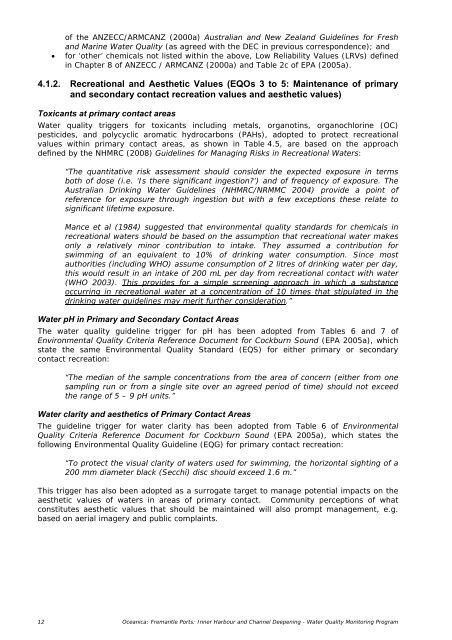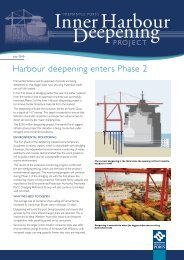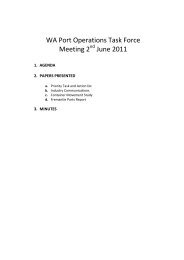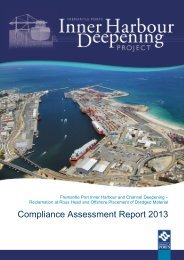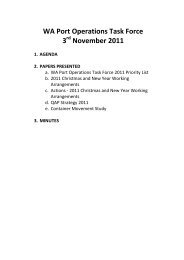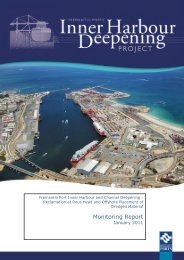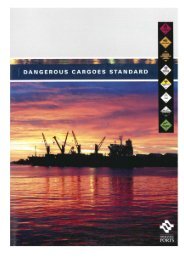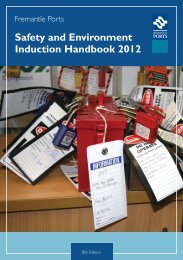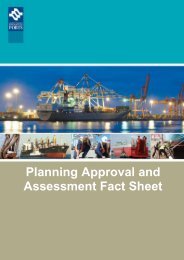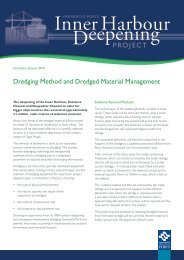Fremantle Port Inner Harbour and Channel ... - Fremantle Ports
Fremantle Port Inner Harbour and Channel ... - Fremantle Ports
Fremantle Port Inner Harbour and Channel ... - Fremantle Ports
You also want an ePaper? Increase the reach of your titles
YUMPU automatically turns print PDFs into web optimized ePapers that Google loves.
of the ANZECC/ARMCANZ (2000a) Australian <strong>and</strong> New Zeal<strong>and</strong> Guidelines for Fresh<br />
<strong>and</strong> Marine Water Quality (as agreed with the DEC in previous correspondence); <strong>and</strong><br />
• for ‘other’ chemicals not listed within the above, Low Reliability Values (LRVs) defined<br />
in Chapter 8 of ANZECC / ARMCANZ (2000a) <strong>and</strong> Table 2c of EPA (2005a).<br />
4.1.2. Recreational <strong>and</strong> Aesthetic Values (EQOs 3 to 5: Maintenance of primary<br />
<strong>and</strong> secondary contact recreation values <strong>and</strong> aesthetic values)<br />
Toxicants at primary contact areas<br />
Water quality triggers for toxicants including metals, organotins, organochlorine (OC)<br />
pesticides, <strong>and</strong> polycyclic aromatic hydrocarbons (PAHs), adopted to protect recreational<br />
values within primary contact areas, as shown in Table 4.5, are based on the approach<br />
defined by the NHMRC (2008) Guidelines for Managing Risks in Recreational Waters:<br />
“The quantitative risk assessment should consider the expected exposure in terms<br />
both of dose (i.e. ‘Is there significant ingestion’) <strong>and</strong> of frequency of exposure. The<br />
Australian Drinking Water Guidelines (NHMRC/NRMMC 2004) provide a point of<br />
reference for exposure through ingestion but with a few exceptions these relate to<br />
significant lifetime exposure.<br />
Mance et al (1984) suggested that environmental quality st<strong>and</strong>ards for chemicals in<br />
recreational waters should be based on the assumption that recreational water makes<br />
only a relatively minor contribution to intake. They assumed a contribution for<br />
swimming of an equivalent to 10% of drinking water consumption. Since most<br />
authorities (including WHO) assume consumption of 2 litres of drinking water per day,<br />
this would result in an intake of 200 mL per day from recreational contact with water<br />
(WHO 2003). This provides for a simple screening approach in which a substance<br />
occurring in recreational water at a concentration of 10 times that stipulated in the<br />
drinking water guidelines may merit further consideration.”<br />
Water pH in Primary <strong>and</strong> Secondary Contact Areas<br />
The water quality guideline trigger for pH has been adopted from Tables 6 <strong>and</strong> 7 of<br />
Environmental Quality Criteria Reference Document for Cockburn Sound (EPA 2005a), which<br />
state the same Environmental Quality St<strong>and</strong>ard (EQS) for either primary or secondary<br />
contact recreation:<br />
“The median of the sample concentrations from the area of concern (either from one<br />
sampling run or from a single site over an agreed period of time) should not exceed<br />
the range of 5 – 9 pH units.”<br />
Water clarity <strong>and</strong> aesthetics of Primary Contact Areas<br />
The guideline trigger for water clarity has been adopted from Table 6 of Environmental<br />
Quality Criteria Reference Document for Cockburn Sound (EPA 2005a), which states the<br />
following Environmental Quality Guideline (EQG) for primary contact recreation:<br />
“To protect the visual clarity of waters used for swimming, the horizontal sighting of a<br />
200 mm diameter black (Secchi) disc should exceed 1.6 m.”<br />
This trigger has also been adopted as a surrogate target to manage potential impacts on the<br />
aesthetic values of waters in areas of primary contact. Community perceptions of what<br />
constitutes aesthetic values that should be maintained will also prompt management, e.g.<br />
based on aerial imagery <strong>and</strong> public complaints.<br />
12 Oceanica: <strong>Fremantle</strong> <strong>Port</strong>s: <strong>Inner</strong> <strong>Harbour</strong> <strong>and</strong> <strong>Channel</strong> Deepening - Water Quality Monitoring Program


